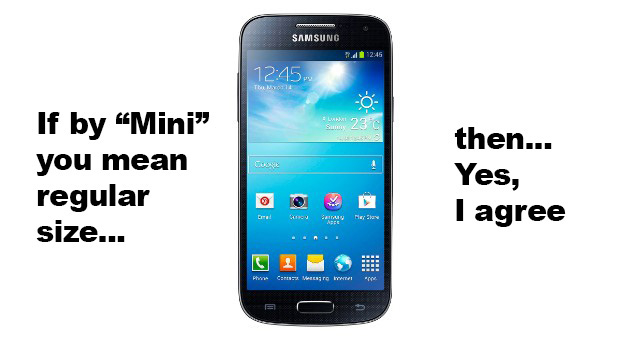Not a Real Trend: "Mini" Smart Phones

These days, picking out a smart phone is like picking your nose, it's going to be messy but you're going to enjoy doing it. The reason why it's so messy is because smart phone manufacturers, looking to differentiate their products from competitors, have exactly one area they can focus on which is screen size. In an article by CNNMoney, apparently "mini" smart phones is the "next hot trend" which sounds ridiculous because it is only marketing PR mumbo-jumbo by re-branding existing screen sizes and cell phones which already exist.
Many industries, as they mature, encounter slowing sales requiring them to differentiate or expand existing product lines. This product differentiation however is often counterproductive and normally leads to customer confusion. A prime example of this is Apple, which after Steve Job's return decided to streamline the company by eliminating numerous existing product lines. Not only does a plethora of smart phone models make it more difficult for consumers to make a buying decision but it also complicates the manufacturing process by requiring additional components and assembly line retooling. That said, there is rarely any incentive for a company to differentiate if there is no market need or if existing products are selling like hotcakes.
Apple maintained a screen size of 3.5" for a number of years while still selling tens of millions of smart phones. Samsung and HTC have both become powerful contenders, with Samsung recently taking the lead in overall market share, while maintaining relatively "normal" screen sizes. Only recently has the trend to larger and larger smart phone screen sizes come to the point of discussion among analysts. In reality, there is no such thing as a "mini" smart phone unless it looks like a watch and has a screen size of 1.5 inches. As a comparison, there is a reason why automobile tires realistically top out at 24 inches. Car wells are only large enough to accept a certain width and depth of consumer tires and even then some vehicles will need to have their fenders rolled to accommodate 24 inch low-profile high-performance tires. Most consumer hands can only comfortably accommodate a smart phone screen size of between 3.5 and 4.5 inches. So why are 5 inch cell phones selling so well? For the most part it is a combination of keeping up with the Joneses, gadget lust and or envy and effective marketing.
In fact, news organizations do consumers a disservice by reporting on non-issues that don't exist and are merely parroting cell phone manufacturer's marketing campaigns. One part of the incorrect analysis is that larger screens cost significantly more to manufacture and pricing pressures create a need to shift to smaller screen sizes. A cost breakdown of the new iPhone5 from iSupply pegged the LCD screen at $44. The total cost of manufacturing an iPhone5 is roughly $200 which is why Apple has ridiculously high profit margins. Even if you add in marketing, shipping, legal and any other business requirements, the net profit is roughly 50% on each iPhone5 sold. Smaller screen sizes have nothing to do with cost and everything to do with maximizing profit margins. Many of these flagship cell phones could be sold for $350 like the Nexus4 from Google and still make money.
Marketing campaigns using the term "mini" in reality create a negative consumer perception of their product by making it seem less substantial to a "regular" smart phone. If anything, smart phone manufacturers should be referring to their absurdly large 5 inch screen size cell phones as "jumbo" denoting that they are obviously outside the norm. I especially love the analyst quotes which state the obvious. One of the more interesting ones is a comment about how smart it would be for Apple to come out with two devices. That's interesting because they already have multiple devices on the market. Older models have both smaller screen sizes and are lower in cost due to slower performing components. But yeah, thanks for stating the obvious. In the future be sure to also get quoted that water is wet and the sky is blue in case someone missed that as well. I also like the quote about how the smart phone market is not "one-size-fits-all" obviously referring to Apple's staunch position of offering a 3.5" screen size over multiple phone iterations. This of course is not accurate since Apple currently offers a 3.5 inch and 4 inch screen size for consumers.
One of the worst things an article can do, besides obviously outright lying and fabricating information, is to quote analysts who; 1. Love to be quoted and 2. Only make statements which support the articles existing premise. It reminds me of those fast food commercials where they show clips of "real" customers extolling the virtues of said product. How about showing me the 300 other clips were customers were indifferent or offered negative feedback. Of course that wouldn't help companies sell something that is of questionable value to consumers.
So in summation, don't believe the hype and fall for any more inaccurate buzzword laden marketing campaigns using doublespeak to put a new spin on existing products. There is no hot new trend in smart phones and if there were it would be because some Senior Executive Vice President of Marketing Nonsense decided it was a good idea to snow consumers by re-branding already current inventory and technology with a new disingenuous moniker.







